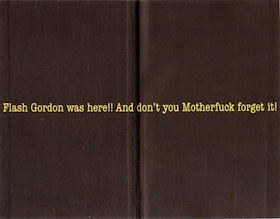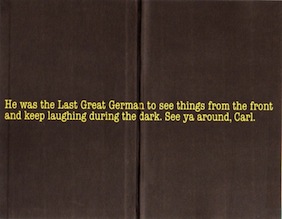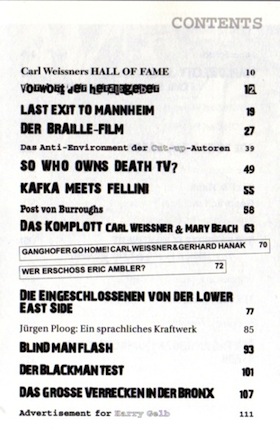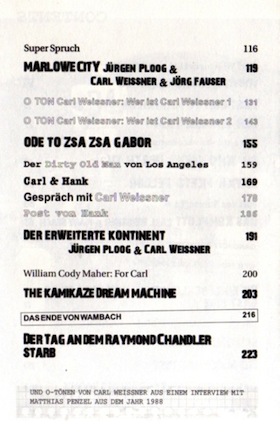+++
Incidental Intelligence: Anyone who cherishes raw truth, and especially those of us who were warmed by Carl Weissner’s friendship, will appreciate EINE ANDERE LIGA as a mammoth achievement. But Milena Verlag ought to correct two claims on its Web site: 1) that this posthumous collection of his underground writings has a foreword written by Sean Penn* — it doesn’t — and 2) that Death in Paris (which comprises half of EAL in a German translation by Walter Hartmann) is Carl’s “only novel in English.” For the record, Death in Paris was the second. His first was The Braille Film, published in 1970. At any rate, neither are novels in the ordinary sense of the term. Both are subversive trips to the nasty depths, swiftly told and brimming with the doomsday wit and black humor that are hallmarks of his writing. *The claim about a foreword by Penn has been removed.
+++
+++
More Incidental Intelligence: Nobody asked me, but I assume the busy look of the production is a punk-style design choice. The editors have a taste for ’80s punk. I’m told the Sean Penn bait-and-switch was supposed to be a joke to entice book buyers, because Milena Verlag is a small publisher hard up for bucks. Which may also account for the proof reading, or the lack thereof. Some of the American texts are marred not just by typos but by typo blight, including howlers like Carl’s “inedible” posts. Hey folks, they were “indelible.” The hardcover binding is luxurious and durable, however, and the book is as thick as a brick. Thank god for that. Postscript: Aug. 4 — “If ‘Death in Paris’ comprises half this work, what does the other half consist of?” Gary Cummiskey asks. Damn good question. The answer is a slew of Carl’s texts in German dating back to the ’60s (cut-ups and so forth), selected from a rich stack of fugitive German underground ‘zines (Klactoveedsedsteen, Gasolin, UFO, others), among them a text called Der Braille Film, excerpted from an essay on cut-ups (not the novel); also some texts in English, such as “The Banzai Freaks vs. The American” (from The Coldspring Journal); and plenty of bonus material, including a scattershot section of letters between Carl and Bukowski that skims the surface of their relationship; collages by Norman O. Mustill; photos of William Burroughs and a letter of his; texts written with Claude Pelieu and Mary Beach; essays and reminiscences by other collaborators and friends of Carl’s (Jurgen Ploog, Cody Maher, among others); and excerpts strung throughout the collection from a 1988 interview in German with Matthias Penzel. I wish Michael Montfort’s portrait of Carl, above, had been included.
+++
+++
PPS: Aug. 5 — It occurs to me that the editors of EAL may not have had more than a smattering of letters in their possession to choose from for the section “Carl & Hank.” (Henry was Buk’s first name.) That would help explain why their selection is “scattershot” and only “skims the surface of their relationship.” In 1997 Carl had to sell most if not all of the letters Buk wrote him between 1973 and 1993 (“175 of them”) and had already returned “earlier ones” to Buk “so he could sell them hiself [sic] in order to buy time for writing his 2nd novel.” See this:
+++
Before that Carl had sold the letters Buk wrote him between 1966 and 1971. (They’re archived in the special collections division of Northwestern University Library.) Meanwhile, here’s something totally weird: Despite Carl’s deep, long-lasting, and productive relationship with Bukowski — as one of Buk’s closest and oldest friends, as his translator, as his European literary agent, who did more for Buk’s career than anyone besides Black Sparrow publisher John Martin and was corresponding with Buk even before Martin arrived on the scene — there is not a single mention of Carl in the most thorough timeline of Buk’s life and career that I’ve seen on the Web. Holy scheisse! Will somebody please correct that?

!['EINE ANDERE LIGA' a posthumous collection by Carl Weissner [Milena Verlag, 2013]](http://www.artsjournal.com/herman/wp/wp-content/uploads/2013/07/AEL-combined-b5601-e1374944753371.jpg)
!['EINE ANDERE LIGA,' a posthumous collection by Carl Weissner [Milena Verlag, 2013]](http://www.artsjournal.com/herman/wp/wp-content/uploads/2013/07/AEL-combined-b560upsidedown-e1374945107884.jpg)


![Carl Weissner [Photo: Michael Monfort]](http://www.artsjournal.com/herman/wp/wp-content/uploads/2013/08/PORTRAIT-OF-CARL-BY-MONTFORT-NACHTMASCHIN180-e1375719458352.jpg)


![Carl Weissner letter to JH [Nov. 12, 1997]](http://www.artsjournal.com/herman/wp/wp-content/uploads/2013/08/CWtoJH12nov97-560a.jpg)
If “Death in Paris” comprises half this work, what does the other half consist of?
Damn good question. The answer, posted above in more detail, is a slew of Carl’s texts in German dating back to the ’60s (cut-ups and so forth), selected from a rich stack of fugitive German underground ‘zines (Klactoveedsedsteen, Gasolin, UFO, others); also some texts in English, such as “The Banzai Freaks vs. The American” (from The Coldspring Journal); and plenty of bonus material, including a scattershot section of letters between Carl and Bukowski that skims the surface of their relationship; collages by Norman O. Mustill; photos of William Burroughs and a letter of his; texts written with Claude Pelieu and Mary Beach; essays and reminiscences by other collaborators and friends of Carl’s (Jurgen Ploog, Cody Maher, among others), and excerpts from an interview in German with Matthias Penzel that are strung throughout the “Stories” collection.
Thank you, Jan! I was curious – so apart from Death in Paris, none of his other book-length works were included.